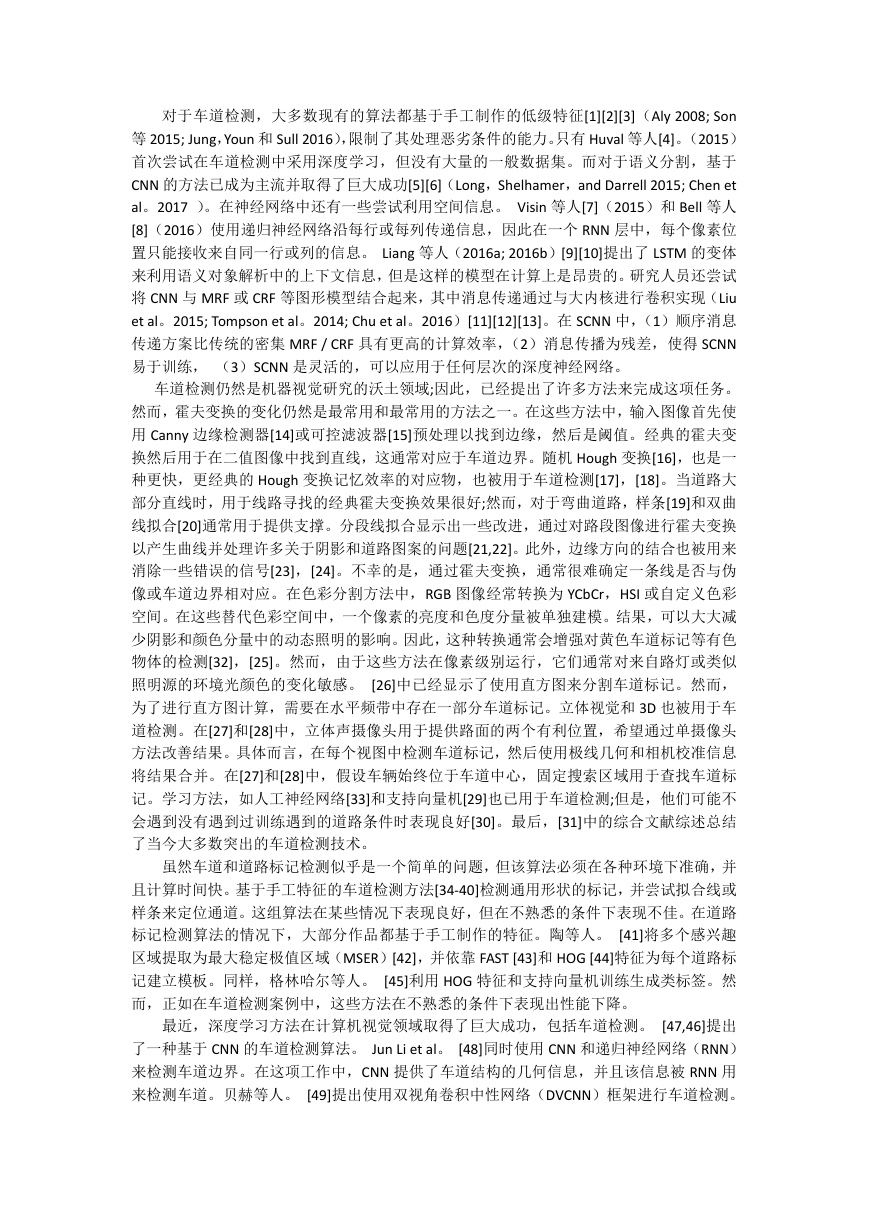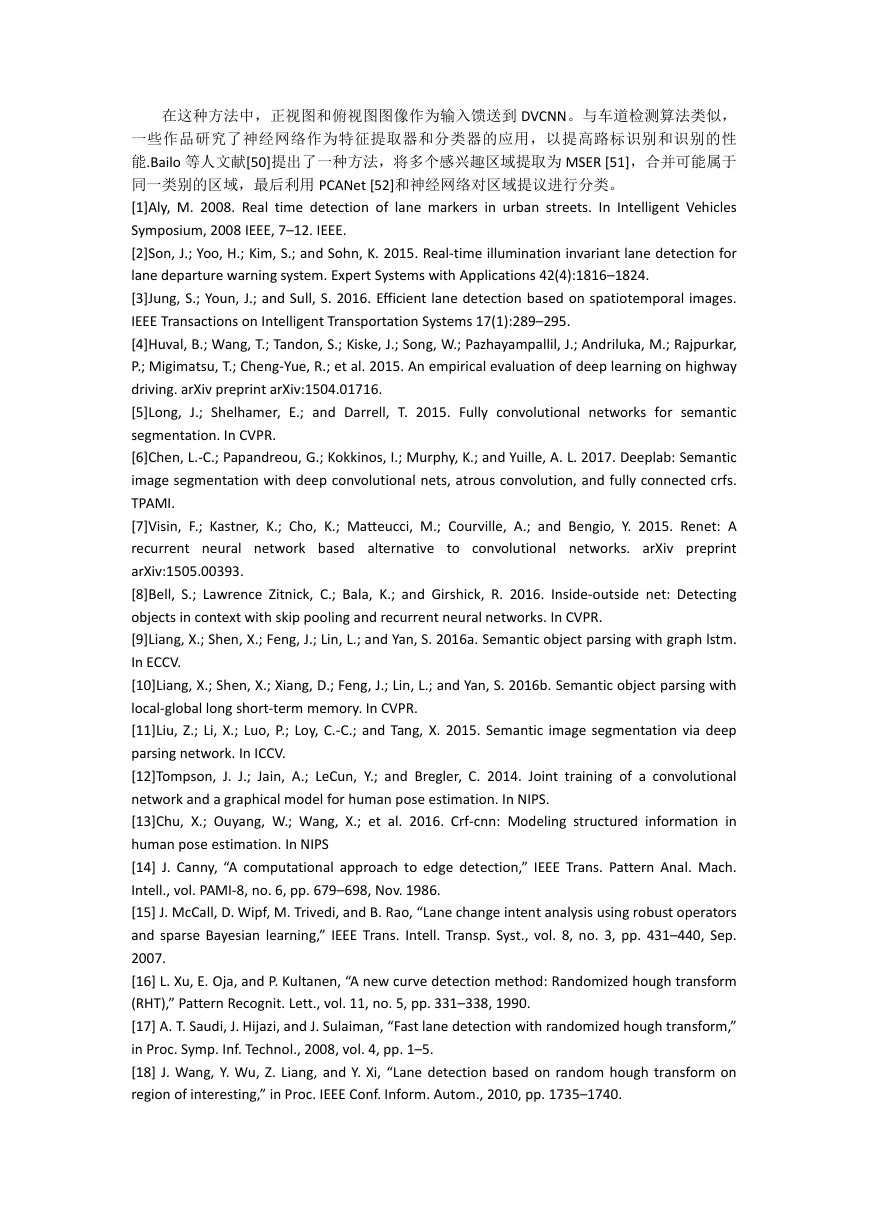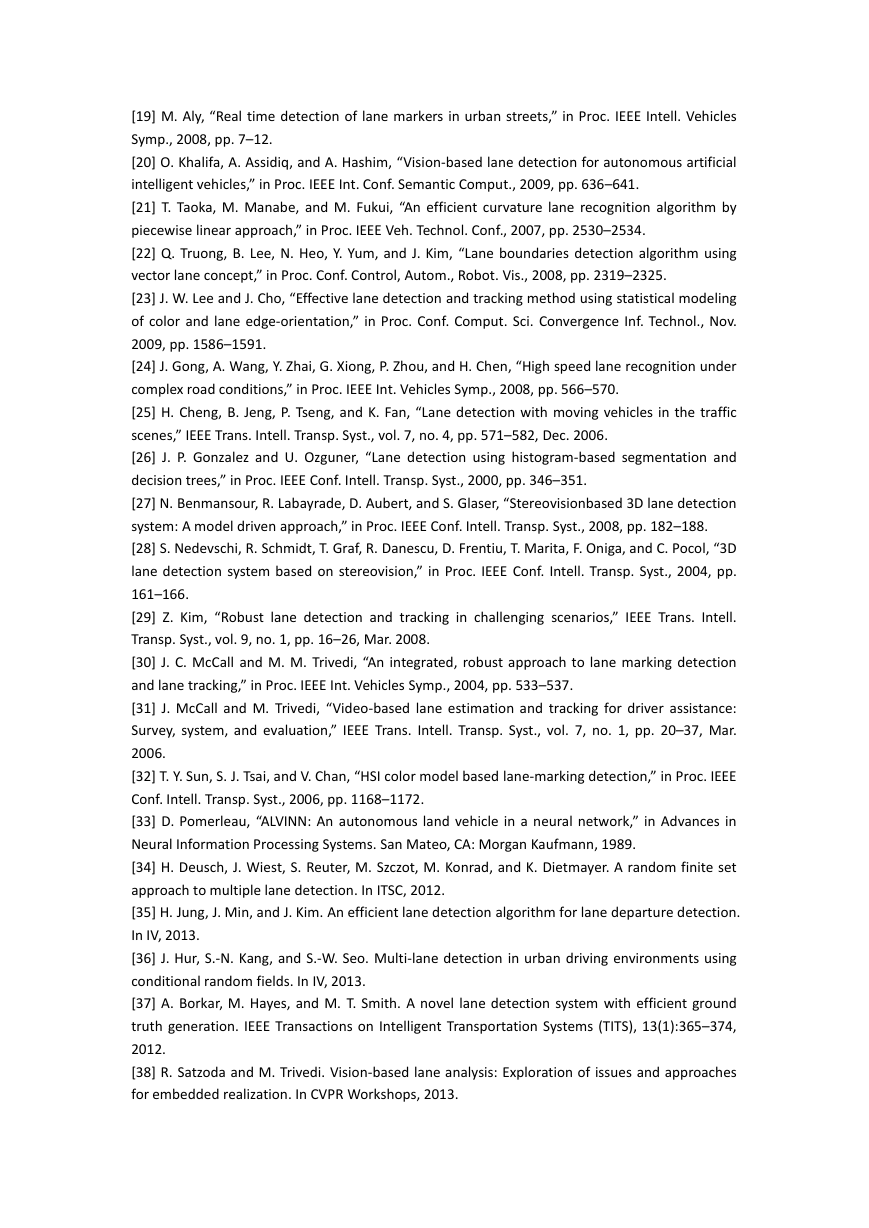对于车道检测,大多数现有的算法都基于手工制作的低级特征[1][2][3](Aly 2008; Son
等 2015; Jung,Youn 和 Sull 2016),限制了其处理恶劣条件的能力。只有 Huval 等人[4]。(2015)
首次尝试在车道检测中采用深度学习,但没有大量的一般数据集。而对于语义分割,基于
CNN 的方法已成为主流并取得了巨大成功[5][6](Long,Shelhamer,and Darrell 2015; Chen et
al。2017 )。在神经网络中还有一些尝试利用空间信息。 Visin 等人[7](2015)和 Bell 等人
[8](2016)使用递归神经网络沿每行或每列传递信息,因此在一个 RNN 层中,每个像素位
置只能接收来自同一行或列的信息。 Liang 等人(2016a; 2016b)[9][10]提出了 LSTM 的变体
来利用语义对象解析中的上下文信息,但是这样的模型在计算上是昂贵的。研究人员还尝试
将 CNN 与 MRF 或 CRF 等图形模型结合起来,其中消息传递通过与大内核进行卷积实现(Liu
et al。2015; Tompson et al。2014; Chu et al。2016)[11][12][13]。在 SCNN 中,(1)顺序消息
传递方案比传统的密集 MRF / CRF 具有更高的计算效率,(2)消息传播为残差,使得 SCNN
易于训练, (3)SCNN 是灵活的,可以应用于任何层次的深度神经网络。
车道检测仍然是机器视觉研究的沃土领域;因此,已经提出了许多方法来完成这项任务。
然而,霍夫变换的变化仍然是最常用和最常用的方法之一。在这些方法中,输入图像首先使
用 Canny 边缘检测器[14]或可控滤波器[15]预处理以找到边缘,然后是阈值。经典的霍夫变
换然后用于在二值图像中找到直线,这通常对应于车道边界。随机 Hough 变换[16],也是一
种更快,更经典的 Hough 变换记忆效率的对应物,也被用于车道检测[17],[18]。当道路大
部分直线时,用于线路寻找的经典霍夫变换效果很好;然而,对于弯曲道路,样条[19]和双曲
线拟合[20]通常用于提供支撑。分段线拟合显示出一些改进,通过对路段图像进行霍夫变换
以产生曲线并处理许多关于阴影和道路图案的问题[21,22]。此外,边缘方向的结合也被用来
消除一些错误的信号[23],[24]。不幸的是,通过霍夫变换,通常很难确定一条线是否与伪
像或车道边界相对应。在色彩分割方法中,RGB 图像经常转换为 YCbCr,HSI 或自定义色彩
空间。在这些替代色彩空间中,一个像素的亮度和色度分量被单独建模。结果,可以大大减
少阴影和颜色分量中的动态照明的影响。因此,这种转换通常会增强对黄色车道标记等有色
物体的检测[32],[25]。然而,由于这些方法在像素级别运行,它们通常对来自路灯或类似
照明源的环境光颜色的变化敏感。 [26]中已经显示了使用直方图来分割车道标记。然而,
为了进行直方图计算,需要在水平频带中存在一部分车道标记。立体视觉和 3D 也被用于车
道检测。在[27]和[28]中,立体声摄像头用于提供路面的两个有利位置,希望通过单摄像头
方法改善结果。具体而言,在每个视图中检测车道标记,然后使用极线几何和相机校准信息
将结果合并。在[27]和[28]中,假设车辆始终位于车道中心,固定搜索区域用于查找车道标
记。学习方法,如人工神经网络[33]和支持向量机[29]也已用于车道检测;但是,他们可能不
会遇到没有遇到过训练遇到的道路条件时表现良好[30]。最后,[31]中的综合文献综述总结
了当今大多数突出的车道检测技术。
虽然车道和道路标记检测似乎是一个简单的问题,但该算法必须在各种环境下准确,并
且计算时间快。基于手工特征的车道检测方法[34-40]检测通用形状的标记,并尝试拟合线或
样条来定位通道。这组算法在某些情况下表现良好,但在不熟悉的条件下表现不佳。在道路
标记检测算法的情况下,大部分作品都基于手工制作的特征。陶等人。 [41]将多个感兴趣
区域提取为最大稳定极值区域(MSER)[42],并依靠 FAST [43]和 HOG [44]特征为每个道路标
记建立模板。同样,格林哈尔等人。 [45]利用 HOG 特征和支持向量机训练生成类标签。然
而,正如在车道检测案例中,这些方法在不熟悉的条件下表现出性能下降。
最近,深度学习方法在计算机视觉领域取得了巨大成功,包括车道检测。 [47,46]提出
了一种基于 CNN 的车道检测算法。 Jun Li et al。 [48]同时使用 CNN 和递归神经网络(RNN)
来检测车道边界。在这项工作中,CNN 提供了车道结构的几何信息,并且该信息被 RNN 用
来检测车道。贝赫等人。 [49]提出使用双视角卷积中性网络(DVCNN)框架进行车道检测。
�
在这种方法中,正视图和俯视图图像作为输入馈送到 DVCNN。与车道检测算法类似,
一些作品研究了神经网络作为特征提取器和分类器的应用,以提高路标识别和识别的性
能.Bailo 等人文献[50]提出了一种方法,将多个感兴趣区域提取为 MSER [51],合并可能属于
同一类别的区域,最后利用 PCANet [52]和神经网络对区域提议进行分类。
[1]Aly, M. 2008. Real time detection of lane markers in urban streets. In Intelligent Vehicles
Symposium, 2008 IEEE, 7–12. IEEE.
[2]Son, J.; Yoo, H.; Kim, S.; and Sohn, K. 2015. Real-time illumination invariant lane detection for
lane departure warning system. Expert Systems with Applications 42(4):1816–1824.
[3]Jung, S.; Youn, J.; and Sull, S. 2016. Efficient lane detection based on spatiotemporal images.
IEEE Transactions on Intelligent Transportation Systems 17(1):289–295.
[4]Huval, B.; Wang, T.; Tandon, S.; Kiske, J.; Song, W.; Pazhayampallil, J.; Andriluka, M.; Rajpurkar,
P.; Migimatsu, T.; Cheng-Yue, R.; et al. 2015. An empirical evaluation of deep learning on highway
driving. arXiv preprint arXiv:1504.01716.
[5]Long, J.; Shelhamer, E.; and Darrell, T. 2015. Fully convolutional networks for semantic
segmentation. In CVPR.
[6]Chen, L.-C.; Papandreou, G.; Kokkinos, I.; Murphy, K.; and Yuille, A. L. 2017. Deeplab: Semantic
image segmentation with deep convolutional nets, atrous convolution, and fully connected crfs.
TPAMI.
[7]Visin, F.; Kastner, K.; Cho, K.; Matteucci, M.; Courville, A.; and Bengio, Y. 2015. Renet: A
recurrent neural network based alternative to convolutional networks. arXiv preprint
arXiv:1505.00393.
[8]Bell, S.; Lawrence Zitnick, C.; Bala, K.; and Girshick, R. 2016. Inside-outside net: Detecting
objects in context with skip pooling and recurrent neural networks. In CVPR.
[9]Liang, X.; Shen, X.; Feng, J.; Lin, L.; and Yan, S. 2016a. Semantic object parsing with graph lstm.
In ECCV.
[10]Liang, X.; Shen, X.; Xiang, D.; Feng, J.; Lin, L.; and Yan, S. 2016b. Semantic object parsing with
local-global long short-term memory. In CVPR.
[11]Liu, Z.; Li, X.; Luo, P.; Loy, C.-C.; and Tang, X. 2015. Semantic image segmentation via deep
parsing network. In ICCV.
[12]Tompson, J. J.; Jain, A.; LeCun, Y.; and Bregler, C. 2014. Joint training of a convolutional
network and a graphical model for human pose estimation. In NIPS.
[13]Chu, X.; Ouyang, W.; Wang, X.; et al. 2016. Crf-cnn: Modeling structured information in
human pose estimation. In NIPS
[14] J. Canny, “A computational approach to edge detection,” IEEE Trans. Pattern Anal. Mach.
Intell., vol. PAMI-8, no. 6, pp. 679–698, Nov. 1986.
[15] J. McCall, D. Wipf, M. Trivedi, and B. Rao, “Lane change intent analysis using robust operators
and sparse Bayesian learning,” IEEE Trans. Intell. Transp. Syst., vol. 8, no. 3, pp. 431–440, Sep.
2007.
[16] L. Xu, E. Oja, and P. Kultanen, “A new curve detection method: Randomized hough transform
(RHT),” Pattern Recognit. Lett., vol. 11, no. 5, pp. 331–338, 1990.
[17] A. T. Saudi, J. Hijazi, and J. Sulaiman, “Fast lane detection with randomized hough transform,”
in Proc. Symp. Inf. Technol., 2008, vol. 4, pp. 1–5.
[18] J. Wang, Y. Wu, Z. Liang, and Y. Xi, “Lane detection based on random hough transform on
region of interesting,” in Proc. IEEE Conf. Inform. Autom., 2010, pp. 1735–1740.
�
[19] M. Aly, “Real time detection of lane markers in urban streets,” in Proc. IEEE Intell. Vehicles
Symp., 2008, pp. 7–12.
[20] O. Khalifa, A. Assidiq, and A. Hashim, “Vision-based lane detection for autonomous artificial
intelligent vehicles,” in Proc. IEEE Int. Conf. Semantic Comput., 2009, pp. 636–641.
[21] T. Taoka, M. Manabe, and M. Fukui, “An efficient curvature lane recognition algorithm by
piecewise linear approach,” in Proc. IEEE Veh. Technol. Conf., 2007, pp. 2530–2534.
[22] Q. Truong, B. Lee, N. Heo, Y. Yum, and J. Kim, “Lane boundaries detection algorithm using
vector lane concept,” in Proc. Conf. Control, Autom., Robot. Vis., 2008, pp. 2319–2325.
[23] J. W. Lee and J. Cho, “Effective lane detection and tracking method using statistical modeling
of color and lane edge-orientation,” in Proc. Conf. Comput. Sci. Convergence Inf. Technol., Nov.
2009, pp. 1586–1591.
[24] J. Gong, A. Wang, Y. Zhai, G. Xiong, P. Zhou, and H. Chen, “High speed lane recognition under
complex road conditions,” in Proc. IEEE Int. Vehicles Symp., 2008, pp. 566–570.
[25] H. Cheng, B. Jeng, P. Tseng, and K. Fan, “Lane detection with moving vehicles in the traffic
scenes,” IEEE Trans. Intell. Transp. Syst., vol. 7, no. 4, pp. 571–582, Dec. 2006.
[26] J. P. Gonzalez and U. Ozguner, “Lane detection using histogram-based segmentation and
decision trees,” in Proc. IEEE Conf. Intell. Transp. Syst., 2000, pp. 346–351.
[27] N. Benmansour, R. Labayrade, D. Aubert, and S. Glaser, “Stereovisionbased 3D lane detection
system: A model driven approach,” in Proc. IEEE Conf. Intell. Transp. Syst., 2008, pp. 182–188.
[28] S. Nedevschi, R. Schmidt, T. Graf, R. Danescu, D. Frentiu, T. Marita, F. Oniga, and C. Pocol, “3D
lane detection system based on stereovision,” in Proc. IEEE Conf. Intell. Transp. Syst., 2004, pp.
161–166.
[29] Z. Kim, “Robust lane detection and tracking in challenging scenarios,” IEEE Trans. Intell.
Transp. Syst., vol. 9, no. 1, pp. 16–26, Mar. 2008.
[30] J. C. McCall and M. M. Trivedi, “An integrated, robust approach to lane marking detection
and lane tracking,” in Proc. IEEE Int. Vehicles Symp., 2004, pp. 533–537.
[31] J. McCall and M. Trivedi, “Video-based lane estimation and tracking for driver assistance:
Survey, system, and evaluation,” IEEE Trans. Intell. Transp. Syst., vol. 7, no. 1, pp. 20–37, Mar.
2006.
[32] T. Y. Sun, S. J. Tsai, and V. Chan, “HSI color model based lane-marking detection,” in Proc. IEEE
Conf. Intell. Transp. Syst., 2006, pp. 1168–1172.
[33] D. Pomerleau, “ALVINN: An autonomous land vehicle in a neural network,” in Advances in
Neural Information Processing Systems. San Mateo, CA: Morgan Kaufmann, 1989.
[34] H. Deusch, J. Wiest, S. Reuter, M. Szczot, M. Konrad, and K. Dietmayer. A random finite set
approach to multiple lane detection. In ITSC, 2012.
[35] H. Jung, J. Min, and J. Kim. An efficient lane detection algorithm for lane departure detection.
In IV, 2013.
[36] J. Hur, S.-N. Kang, and S.-W. Seo. Multi-lane detection in urban driving environments using
conditional random fields. In IV, 2013.
[37] A. Borkar, M. Hayes, and M. T. Smith. A novel lane detection system with efficient ground
truth generation. IEEE Transactions on Intelligent Transportation Systems (TITS), 13(1):365–374,
2012.
[38] R. Satzoda and M. Trivedi. Vision-based lane analysis: Exploration of issues and approaches
for embedded realization. In CVPR Workshops, 2013.
�
[39] H. Tan, Y. Zhou, Y. Zhu, D. Yao, and K. Li. A novel curve lane detection based on improved
river flow and ransa. In ITSC, 2014.
[40] P.-C. Wu, C.-Y. Chang, and C. H. Lin. Lane-mark extraction for automobiles under complex
conditions. Pattern Recognition, 47(8):2756–2767, 2014.
[41] T. Wu and A. Ranganathan. A practical system for road marking detection and recognition. In
IV, 2012.
[42] J. Matas, O. Chum, M. Urban, and T. Pajdla. Robust widebaseline stereo from maximally
stable extremal regions. Image and Vision Computing, 22(10):761–767, 2004.
[43] D. G. Viswanathan. Features from accelerated segment test (fast), 2009.
[44] N. Dalal and B. Triggs. Histograms of oriented gradients for human detection. In CVPR, 2005.
[45] J. Greenhalgh and M. Mirmehdi. Automatic detection and recognition of symbols and text on
the road surface. In ICPRAM, 2015.
[46] J. Kim and M. Lee. Robust lane detection based on convolutional neural network and random
sample consensus. In ICONIP, 2014.
[47] B. Huval, T. Wang, S. Tandon, J. Kiske, W. Song, J. Pazhayampallil, M. Andriluka, P. Rajpurkar, T.
Migimatsu, R. Cheng-Yue, et al. An empirical evaluation of deep learning on highway driving.
arXiv preprint arXiv:1504.01716, 2015.
[48] J. Li, X. Mei, and D. Prokhorov. Deep neural network for structural prediction and lane
detection in traffic scene. IEEE Transactions on Neural Networks and Learning Systems (TNNLS),
PP(99):1–14, 2016.
[49] B. He, R. Ai, Y. Yan, and X. Lang. Accurate and robust lane detection based on dual-view
convolutional neutral network. In IV, 2016.
[50] J. Matas, O. Chum, M. Urban, and T. Pajdla. Robust widebaseline stereo from maximally
stable extremal regions. Image and Vision Computing, 22(10):761–767, 2004.
[51] O. Bailo, S. Lee, F. Rameau, J. S. Yoon, and I. S. Kweon. Robust road marking detection and
recognition using densitybased grouping and machine learning techniques. In WACV, 2017.
[52] T.-H. Chan, K. Jia, S. Gao, J. Lu, Z. Zeng, and Y. Ma. Pcanet: A simple deep learning baseline for
image classification? IEEE Transactions on Image Processing (TIP), 24(12):5017–5032, 2015.
�








 2023年江西萍乡中考道德与法治真题及答案.doc
2023年江西萍乡中考道德与法治真题及答案.doc 2012年重庆南川中考生物真题及答案.doc
2012年重庆南川中考生物真题及答案.doc 2013年江西师范大学地理学综合及文艺理论基础考研真题.doc
2013年江西师范大学地理学综合及文艺理论基础考研真题.doc 2020年四川甘孜小升初语文真题及答案I卷.doc
2020年四川甘孜小升初语文真题及答案I卷.doc 2020年注册岩土工程师专业基础考试真题及答案.doc
2020年注册岩土工程师专业基础考试真题及答案.doc 2023-2024学年福建省厦门市九年级上学期数学月考试题及答案.doc
2023-2024学年福建省厦门市九年级上学期数学月考试题及答案.doc 2021-2022学年辽宁省沈阳市大东区九年级上学期语文期末试题及答案.doc
2021-2022学年辽宁省沈阳市大东区九年级上学期语文期末试题及答案.doc 2022-2023学年北京东城区初三第一学期物理期末试卷及答案.doc
2022-2023学年北京东城区初三第一学期物理期末试卷及答案.doc 2018上半年江西教师资格初中地理学科知识与教学能力真题及答案.doc
2018上半年江西教师资格初中地理学科知识与教学能力真题及答案.doc 2012年河北国家公务员申论考试真题及答案-省级.doc
2012年河北国家公务员申论考试真题及答案-省级.doc 2020-2021学年江苏省扬州市江都区邵樊片九年级上学期数学第一次质量检测试题及答案.doc
2020-2021学年江苏省扬州市江都区邵樊片九年级上学期数学第一次质量检测试题及答案.doc 2022下半年黑龙江教师资格证中学综合素质真题及答案.doc
2022下半年黑龙江教师资格证中学综合素质真题及答案.doc